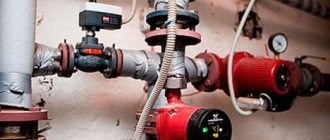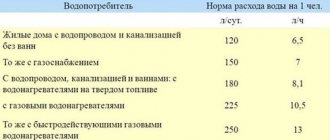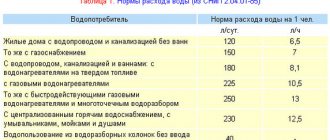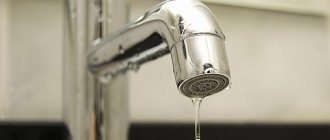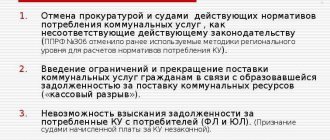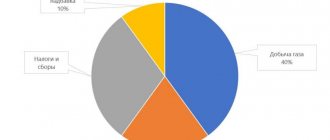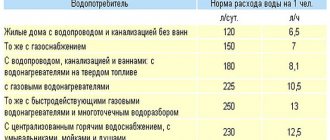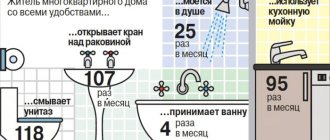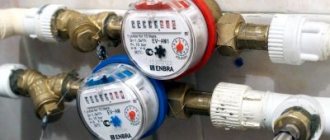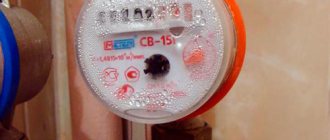The legislative framework
Government Decree No. 354 provides information regarding the provision of housing and communal services. There are also formulas with which you can calculate the volume of water consumed. They differ depending on whether a water meter is installed in the apartment.
Over the past 30 years, there have been no changes in water consumption standards. However, these values vary depending on the type of residential building.
Prices for 1 m3 of water are set by local authorities in all regions. In this case, the norms from Federal Law No. 210-FZ must be taken into account.
Water consumption standards are regulated in the following situations:
- if there are no common meters in a residential building;
- if the deadlines for sending data are not met and several months in a row are missed (more than six months);
- when the tenant refuses to provide water meter readings;
- in case of malfunction of the metering device and the need to replace it.
Such laws are aimed at ensuring that citizens install flow meters. Otherwise, they will have to pay fixed rates, which could result in actual costs being several times higher.
Actual consumption
It should not be assumed that the installation of meters necessarily entails the need to reduce the usual water consumption. In fact, people are required to control their own consumption of the resource and not pour water in vain. In any case, this is not a typical situation - to spend a resource beyond the norm, even if a person does laundry, wet cleaning and bathing every day. In practice, after installing hot and cold water meters, payments are reduced by two or even three times. Of course, if you do not take into account those cases when one person is registered in a living space, but in fact four live. In such cases, without meters, payments will be less than with them.
Another advantage of meters is that a person pays only for what he actually consumed. If he went on vacation or a long business trip and no one used the water in his house during this period, he will not pay for it. If there are no meters, whether someone was at home or absent for three months, you will have to pay according to tariffs.
By comparing water consumption rates per person per month with actual consumption, monthly expenses for all expense items are calculated.
Taking this data into account, the following monthly averages apply throughout the country:
- Visiting the toilet – 118 times (in dormitories 123 times);
- Washing in the bathroom – 4 times;
- Taking a shower – 25 times (in dormitories 17 times);
- Use of the sink – 107 times;
- Use of the kitchen sink – 95 times.
Standard cold water per person without the use of a water meter
Before water standards per person were introduced, general house flow meters were installed. With their help, the amount of water consumed by the residents of the entire house was determined. This amount was then divided by the number of apartments in the building. This method was not entirely fair for the population, since some people spent less resources, while others spent more.
Therefore, standards were introduced. For one person over a thirty-day period, the standards for cold water are 6.935 m3. If you divide this amount by 30, you get approximately 200 liters of water for one day. To make it clearer, the volume of a standard bath is about 250 liters. Not all people take it daily. Therefore, we can conclude that these standards are very high, even if a person uses plumbing every day.
Moreover, utility companies have the right to increase this standard to cover costs, but not more than 2 times. In this case, the service fee will be even higher.
When obtaining the standard value, the natural needs of the population, which require the use of water, were taken into account. These include the following:
- Washing in the shower. This requires about 30 liters of water per day.
- Washing, shaving and other daily needs. A person spends about 200 liters per week on this.
- Going to the toilet. On average, a person uses up to 200 liters per day when flushing the toilet cistern. If the plumbing leaks, costs can increase to 260 or more liters. In this case, the costs will be even more impressive.
- Taking a bath. This takes up to 400 liters per week.
- Cooking, washing dishes, cleaning, laundry. This requires another 500 liters per week.
- The cost of water required to maintain the house is also included. For example, washing common areas, entrances and others.
- Other expenses. Approximately 800 liters per year are allocated for them.
Taking into account all the above needs, a number was obtained that is the norm for water consumption per person per month. Almost 7 m3 is quite enough, even if you don’t save water. In many cases, consumption does not even reach the norm.
Important! The maximum rate of water used in 30 days should not exceed double the rate. That is, utility companies cannot demand payment for more than 14 m3 over a thirty-day period. Otherwise, you can complain about them.
Payment for the resources provided is taken for each person registered in the house, even if he does not live here. Persons with temporary registration are also taken into account.
In the absence of a water meter, there is no need to save, since the payment is fixed. However, even without savings it will be difficult to reach the applicable standards. Therefore, this option is less preferable.
If a water meter is installed, costs are determined for each apartment separately, depending on the amount of liquid flowing through the water pipes.
There are also monthly standards for wastewater disposal. They amount to 11.68 m3 per person. This includes the costs of DHW and cold water. Utilities also have the right to raise this value.
Applicable coefficients
If there is an internal water supply and sewerage system, hot water supply, the coefficients range from 1.25 to 1.15 k/hour. Under the same conditions, in the presence of a bathtub and a gas water heater, the coefficient values are from 1.2 to 1.15 k/hour. The situation is somewhat different with the presence of a bathroom and wood-burning heaters - from 1.4 to 1.2 k/hour. With the presence of internal water supply, but without a bathroom, indicators from 1.6 to 1.4 k/hour are used.
Water consumption standards necessarily include cost items for fire extinguishing. However, since such needs are classified as periodic, the principles of calculation are based on the localization of the fire point and the supply of resources to influence it. Here the specifics of the premises must be taken into account.
Another indicator of standard water volume consumption is the location of a shower or bathtub in the room. Residential houses, which have a built-in water supply and sewerage system, but are not equipped with a bathroom, are designed to consume from ninety-five to one hundred and twenty liters of water per day. This is an indicator of water use per person. If a similar house has a bathroom, as well as devices for heating the water resource, the norms increase to one hundred and eighty liters per day.
What are multiplying factors?
If there are no flow meters, but their installation is possible, so-called increasing factors apply. That is, the payment for water increases slightly - for 2021 it is 1.5. This law was introduced in 2021, and in accordance with it, household expenses are increasing.
This measure was introduced to ensure that citizens of the country install meters in their apartments. It is also necessary to install common house appliances necessary to control the amount of water used throughout the house.
Standard hot water per person per month
In order to set hot water standards for a month, the regional government must allocate statistical research. On this basis, both N is assigned - the regional standard for the consumption of cold or hot water supply, and T - that is, the regional tariff. In 2021, the transition to a two-component payment for hot water supply continued.
Saving options
Now the consumer will pay every month not for a cubic meter of hot water already received, but for the cold water consumed and the energy spent on heating it.
Formulas for calculating water consumption
The amount of resources used is calculated using special formulas. The final cost of payment will depend on the temperature of the liquid, as well as the presence or absence of a water meter. The formulas are developed by the legislation of the Russian Federation.
There is no technical possibility to install the device
If it is technically impossible to install a meter in an apartment, then the formula for calculating water will look like this:
P = n*N*T, where:
N – standard cold water per person per month (may vary by region and service provider);
n – the number of people officially living in the house (tenants with permanent and temporary registration);
T is a fixed tariff for paying for water without a meter, which is valid within the region under consideration.
Installation of a water meter is possible
If a water meter is not installed, but there are no technical obstacles to this, the water tariff increases. It will be 1.5 times larger, unlike those who have installed water meters. Therefore, one more component will be included in the formula. As a result, the price will be calculated as follows:
P = n*N*T*K, where:
n – the number of residents who have temporary or permanent registration in a given premises;
T – water tariff;
N – water norm per person per month;
K – increasing coefficient.
Thus, it turns out that it is much more profitable to install a water meter. Payment will be made according to how much water was used over the past month. While for people without a meter, the amount to be paid will be calculated based on the water norm for a thirty-day period.
Attention! It is imperative to keep track of when the check date for water consumption meters expires. After all, if you delay sending the water meter data by 6 months, the calculation can also be carried out according to the standard.
Features of water supply rationing in rural areas
The supply of water to private houses in rural areas is subject to rationing in the case of centralized water supply to consumers by utility companies. It is possible to assign a separate payment if there is a water stand on a public street.
We recommend: Sensors for detecting gas leaks
It must be taken into account that water is additionally consumed for watering the garden, therefore, in the appropriate season, if there is no water meter in a private house, a separate fixed amount is assigned for these needs.
If residents of the private sector do not provide water supply centrally, including installation and maintenance of systems, utility standards are not applicable in this situation.
DHW standard without water meter
The rate of hot water per person for a thirty-day period is lower compared to cold water and amounts to 4.745 m3. Also, utility companies have the right to increase this norm (but not more than 2 times) if there is a cash shortage. Therefore, the norm is 4.745 x 2 m3. The amount of water spent in winter for heating is calculated separately.
Attention! It doesn't matter if someone lives in the apartment. Owners will have to pay the amount of services according to the standard, with mandatory consideration of how many persons are registered in the premises.
Based on this, one person should consume no more than 13-140 liters of hot water per day. However, you can spend resources without saving them - regardless of actual consumption, the calculation cannot be more than the established standards.
How much water does a person need per day
According to many experts, the norm for human water consumption per day is 1.5 liters. The “8 glasses” rule is popular among fitness club trainers. However, it is difficult for many to get used to such standards, and some doubt that this displacement is the same for everyone.
And they do the right thing: the required amount of water is different for all people and it depends on many factors.
This includes, in addition to 1.5 liters of clean drinking water, liquid that enters the body with food, including compotes, fresh juices and dairy products. Also, every day approximately 300 ml of fluid is formed in the human body due to biochemical reactions.
How is the norm of drinking water per person per day determined?
How to determine the amount of water needed
As mentioned above, there are many factors that need to be taken into account to find out how much water a particular person needs to drink per day.
The main ones are:
- Gender. Since men have more muscle tissue, which consists of 70-80% water, than women, their need for fluid is greater and amounts to 2 liters. Women sweat less than men, so the average daily water requirement for them is 1.5 liters.
- Activity and body weight. A person’s daily need for water increases if he is actively involved in sports or physical labor - it can reach 3 liters or even more.
- Also, the required water consumption is adjusted according to the person’s weight: 30-40 g of water is needed per 1 kg. For those who play sports, there is a special American drinking regimen. According to it, during training you need to take 3-5 sips of water every 15-30 minutes. And at the end of the workout, it is advisable to drink the amount of water corresponding to the weight loss.
- Seasonality. Of course, in winter the body requires much less water than in summer. But even if you absolutely don’t want to drink, you need to do this to avoid dehydration, the signs of which are drowsiness, weakness, brittle nails, and dry skin.
In order to feel good in the summer, you need to constantly replenish the lack of moisture. The water consumption required to maintain water balance increases with increasing air temperature. So, if at 21°C 1.5 liters of water are needed per day, then at 32°C – 3 liters.
Standards and tariffs by city for 2019
The above standards are an average. However, this indicator differs for different regions of Russia. Also, these values may vary depending on the type of house - they differ for private and multi-apartment buildings. Tariffs vary depending on the territory.
Let's consider the prices for water set in different cities of Russia. All the necessary information is presented in the table below.
| City | HVS | DHW | ||
| m3/person | rub. per 1 m3 | m3/person | rub. per 1 m3 | |
| Moscow | 6,935 | 38,06 | 4,745 | 188,53 |
| Saint Petersburg | 5,36 | 25 | 3,89 | 100 |
| Novosibirsk | 5,193 | — | 3,687 | 89,11 |
| Krasnodar | 4,04 | — | 2,65 | — |
| Ekaterinburg | 5,62 | — | 5,04 | — |
| Ufa | 6,365 | 12,5 | 2,582 | 57,2 |
| Rostov-on-Don | 6,5 | — | — | — |
| Chelyabinsk | 4,25 | — | 3,11 | — |
| Voronezh | 5,1 | — | 3,07 | — |
| Permian | 5,6 | 31,6 | 3,4 | 152,2 |
| Kazan | 6,73 | — | 3,44 | — |
| Samara | 7,9 | 27,1 | 3,6 | 130,2 |
In places where a dash is indicated, the exact data is unknown.
Attention! Actual prices may vary slightly from those shown above. This depends on the utility provider.
Additional consumption indicators
Based on the above, we can also mention that, according to statistics, water is used thirty-one times per month for cleaning homes and the same amount for washing clothes. Certain regions of the Russian Federation have more specific data regarding the consumption of cold and hot water.
Consumer water consumption standards for sanitary needs according to some utility services:
- Taking a shower - up to one hundred liters;
- Bathing in the bathroom - about two hundred to three hundred liters;
- One-time visit to the toilet - up to six liters.
It is also necessary to take into account that even when the bathroom is used frequently, with its capacity of two hundred and fifty liters and everyday washing, there are water consumption rates that are inflated - increasing coefficients. Of course, no government agencies can control the amount of resource used in each individual apartment, therefore, in order to avoid unwanted overpayments, the most correct solution is to install meters.
In addition, if we consider the capital regions, then per person per month there are 3.81 cubic meters. hot in water and 5.48 cu. cold water. If there are no meters, the owners are obliged to pay the tariffs established in the region, regardless of how much they actually consumed.
How to save water in an apartment
When a water meter is not installed, people pay much more than they actually spend. After all, the standards established by law are very high and do not correspond to the real needs of consumers. Such standards are established to compensate for water losses, which can be caused by various reasons (accidents, worker negligence, etc.).
For example, a pipe burst, it was not immediately noticed, and then it was not immediately repaired. As a result, water flowed freely for several days. The loss of resources can be very significant. And payments for the negligence of workers will be made by the residents of the house - the water standard can be increased by 2 times.
In reality, the amount of water used per month is 2-4 times lower. Even if you do not save water, its consumption reaches 4 m3 of cold and 3 m3 of hot.
Therefore, it is much more profitable to install a water meter. This way it will even be possible to reduce the consumption of water resources, avoiding unnecessary waste. Due to this, you can save a lot. Moreover, the savings can be quite impressive - up to several hundred rubles per month per person. And if several persons are registered in the apartment at once, then this amount increases a couple of times.
There are a number of simple rules that will help save consumed resources:
- Take a shower, not a bath. If you fill the bathtub to the top, up to 200 liters of liquid will be lost at a time. According to statistics, much less water is wasted when taking a shower - up to 50 liters.
- Take a bath together. This way you can spend half as much resources.
- Try to be in the shower less. You don't need to take a long shower in the morning to perk up. You can do this by drinking a cup of coffee. Moreover, it is necessary to take into account that prolonged exposure to hot water can negatively affect the condition of the skin.
- Run the dishwasher with a full load. If you fill it only halfway, a lot of excess liquid will be wasted. And for maximum savings, you can wash dishes in a basin.
- Run only a filled washing machine. But you shouldn’t overcrowd it, as this could quickly cause the device to fail. It is recommended to use modern washing equipment. New machines use 50% less water than older models.
- Install a wastewater recycling system. Purified water can be used to water flowers, wash areas, and so on.
- Monitor the functioning of plumbing fixtures. If a leak is detected, it must be repaired immediately. For example, a leaking toilet can generate up to 16,000 excess water per year.
- Turn off the tap while brushing your teeth and turn it on only to wash your toothbrush.
- Place the filled bottle into the toilet cistern. This method will allow you to save a lot of money.
- Use an economical toilet flush. Usually there are two buttons on the drain tank - one larger, the second smaller. You need to press the small one so that less liquid is drained.
- To wash your car, use a bucket of water rather than a hose. And then, to rinse, you can water the car with a hose.
It is also recommended to check your water meter readings regularly. This will allow you to monitor the amount of water used. These simple steps will help you use less water and lower your monthly utility costs. But it’s wiser to save hot water, because cold water costs a penny.
Thus, charging for water using a water meter is much more profitable than charging according to standards. Indeed, in this case, residents pay only for the resources used, regardless of the number of people registered in the apartment. Installation of the meter is carried out at the personal expense of the owner of the premises. In houses with a single central riser, it is enough to install two devices - separately for hot water supply and hot water supply. If you live in an apartment building where there are two central risers, you will have to install 4 meters - two for hot water supply and two for hot water supply.
After installing the device, you will need to call a housing and communal services representative to complete the accounting. As a result, you will have to spend money on installing the meter. However, in the future, all costs will pay for themselves through savings on utility bills. The greatest savings will be observed in the summer, when many people go to the country. But if there is no meter, you will have to pay a fixed amount, even if there is no one in the apartment for an extended period of time.
Reasons for high meter consumption
When a significant amount is charged for water consumption per month, the question arises: what are the reasons for such excessive consumption of water resources?
Why does the meter move a lot?
It happens that the meter has been verified and installed, the pipeline is new and there are water filters, but the water meter readings are simply surprising.
If the meter in the apartment increases a lot, you need to consider the following points in more detail:
- Water leakage from the pipeline system in the apartment:
- toilet flush cistern with a leaky flush valve and losses of up to 2-3 m³ of cold water per month;
- valves that are not tightly closed and water is dripping from them.
- Reluctance to rationally use water by all residents of the apartment:
- taking a full bath;
- long showers;
- daily laundry or washing dishes with an incomplete load;
- taps that are not closed when washing or brushing teeth, washing dishes or cleaning the apartment.
Why does it show inflated numbers?
Sometimes the reason for increased water consumption lies not in residents or plumbing fixtures, but in the nuances of the water meter or pipeline supplying hot or cold water:
- Problems with the installation of the water meter and the device itself:
- failure of the sealant in the water meter manifests itself in the form of fogged glass above the meter scale or leaks in the body;
- erroneous installation and installation of a water meter for hot water to cold water supply and vice versa, which leads to inflated tariffs.
- Condition of the water supply network and supplied water:
- high content of foreign impurities in pipeline water - rust or salts, which are deposited on the rotating blades of the meter and change the speed of rotation of the numbers on the dial;
- high water pressure in high-rise buildings leads to water losses if consumption is neglected - up to 20 liters per minute (find out what to do with low pressure and about pressure standards in pipes);
- the forced need to drain hot water of inappropriate temperature, paying for warm water according to the hot tariff schedule.
Increasing coefficient for water without a meter from 2021
Now the housing and communal services receipt has a special line that contains the abbreviation “PC”. This means a multiplying factor. It is allocated for the purpose of:
- ensure transparency of utility billing;
- clearly show the difference between a board with and without a PC.
Thus, the population is encouraged to purchase metering devices.
The basis for introducing a multiplier is a number of regulations. Therefore, it is legally possible not to pay for it if this is not possible for technical reasons.
Or (the best option) install individual metering devices in the apartment.
The majority of the population does not want to overpay money in vain. Therefore, they purchased and installed meters. In 2-3 years, their expenses are fully justified. Who belongs to them:
- there are more people registered in the apartment than live;
- often leave for a long time;
- no one is registered in the apartment, and the owner lives elsewhere;
- use resources sparingly.
However, there are people who benefit from paying according to the standards. This:
- there are many more people living in the premises than registered;
- among the residents there is a beneficiary for housing and communal services;
- the apartment is for rent.
Also, residents of communal apartments and dormitories often do not install individual meters. Or communal meters are installed there. And the required amount is distributed among all residents.
Rumors about the abolition of the coefficient are constantly circulating in society. Too many people are unhappy with its introduction. Such a bill has not been adopted. Moreover, adoption is not planned yet.
According to the latest news, there is an idea to replace the increasing coefficient with analog payments. That is, the neighboring house or apartment in which the meters are installed is taken as a sample for average resource consumption. And a similar payment is charged for apartments that pay according to the standards. But this is all only at the level of ideas.
However, the possibility of canceling the payment of utility bills at one and a half times the rate for low-income families is being considered. They do not have the funds needed to purchase and install meters. Such expenses can seriously undermine an already meager budget.
In addition, in some regions of the country the authorities have made the installation of meters free of charge.
The government plans to further modernize the housing and communal services complex. For example, from the end of 2021, in all new buildings they want to install new models of individual metering devices, which independently transmit their readings remotely once a month. You just need to enter a specific program. We will soon see for ourselves whether this plan will come true.
Since 2015, the installation of devices for metering consumed resources has become mandatory. Consumers who have installed meters make payments for utilities according to their readings. The rest will still have to pay based on established standards.
The procedure for determining the norm of water consumption per resident is established by Decree of the Government of the Russian Federation of May 23, 2006 N 306. According to this resolution, standards for utility services are finally formed by regional authorities.
When approving them, the characteristics of a residential or private house are taken into account. The standard is calculated per month. For cold and hot water it is calculated in cubic meters. On average, per month there are 6,935 cubic meters per resident. h.v. and 4.75 cu. g.v..
If meters are not installed in the apartment, then the payment for hot water and hot water is calculated based on these indicators. If you have metering devices, you need to pay for the amount of resource actually spent.
The water consumption rate for 2021 for St. Petersburg (according to the appendix to the order of the Tariff Committee) is:
- cold water supply 4.90 cubic meters,
- hot - 3.48 cubic meters.
For Moscow:
- cold water - 6.94;
- hot - 4.75 cubic meters.
How not to pay according to standards
The only way not to pay for water consumption standards established by law is to install metering devices. If the liquid is heated in a central system, in addition to meters for cold water, experts recommend installing separate hot water meters.
You will have to spend quite a significant amount to purchase a water meter and its installation services. However, given the volume of cost reductions, it will pay off in the next few months. By installing a water meter, you get the following benefits:
- the ability to accurately determine how much of a resource is actually consumed during the reporting period. In most cases, it is significantly less than the consumption rate;
- the ability to pay only for what was used by the people actually living in the apartment, those registered (but not living) are not taken into account in this case;
- the opportunity to find out exactly where water is wasted in the largest quantities, and, accordingly, to find opportunities for savings;
- the ability to accurately set the temperature in the hot water supply system. If it is lower than the indicator established by law, it is allowed to pay at the tariff provided for cold;
- the opportunity not to pay for water at all if you are not temporarily living in a house or apartment (you are on vacation, a business trip, or at the dacha). If the meter is not installed, the absence or presence of residents (and, accordingly, actual water consumption) does not matter. Payment is made in accordance with the current norm and the number of registered citizens.
Average consumption figures for the Russian Federation
The norm of cold water per person is a variable value, and in different regions of Russia it differs significantly. Here is a list that includes statistics from the largest regions of the country regarding water consumption standards per citizen:
- Yekaterinburg - 4.25 m3.
- Moscow - 6.89 m3.
- St. Petersburg - 3.35 m 3.
- Perm region - 5.78 m3.
- Leningrad region - 4.90 m3.
- Novosibirsk - 5.91 m3.
The rate of hot water per person is approximately 166 liters per month, while about 233 liters of cold water are used. The Ministry of Construction claims that the average Russian uses water and plumbing fixtures the following number of times each month:
- using the toilet - 118 times;
- washing in the shower - 25 times;
- washing dishes - 95 times;
- takes a bath - 4 times;
- sink use - 107 times.
General household needs, which include laundry and wet cleaning, amount to about 31 times. Based on the above data, you can understand why the norm of cold water per person is higher than hot water. The cost of supplying it is cheaper, and therefore residents of households will use it in larger quantities.
When normative values apply
The standard water consumption without a meter per person is the value of the monthly volume of water consumption, which is used to establish the amount of payment in cases provided for by the Rules for the provision of utility services in clauses 24, 31, 32:
- lack of individual or communal metering devices,
- in case of long-term (more than six months) absence when providing water meter readings,
- if the owner systematically refuses to provide the resource supply company with indications,
- when replacing or repairing a faulty flow meter, etc.
The legislation of the Russian Federation obliges owners and management organizations to install water meters, since the amount of payment for utility services is calculated based on the volume recorded by water meters. When establishing two-component tariffs based on the consumption rate per person, the calculation for hot water according to the meter includes the consumption according to the standard of thermal energy required to heat the cold hydroflow. That is, the two-component tariff consists of the sum of the cost of the component of the cold water resource intended for heating, and the cost of the component of thermal energy used for heating.
However, in the absence of water meters or their failure, standard values are applied, approved, in accordance with the Housing Code of the Russian Federation, Article 157, paragraph 1, by local government bodies, for example, by orders of the Regional Tariff Department.
So, for example, social standards for hot water consumption in Moscow 2021, calculated according to the standard, are 4.745 m 3, cold water - 6.935 m 3 and a total of 11.68 m 3 per month. For comparison, in Novosibirsk in the same period of the first half of 2021, the following values were established, based on cubic meters per person per month:
- For houses where it is technically possible to install water meters - DHW: 5.162; Cold water: 7.270. Standard water consumption for general house needs (since April 2015) for hot water supply and hot water supply: 0.038.
- For houses where it is not technically possible to install water meters - hot water supply: 3.687, cold water supply: 5.193. Payment according to the standards of a common house water meter: 0.027.
Who sets standard values and how?
The rate of consumption of cold and hot water without a meter per person (daily and per month) 2015-2016 is determined according to the regulatory Rules for the consumption of utilities, approved by Resolution No. 306 of the Government of the Russian Federation. Specific values for the specified period are approved by authorized bodies, which include local government bodies. The basis is taken in detail in SNiP standards for consumption of cold and hot water by consumers, which, according to Appendix No. 3 (2.04.01-85), are treated with additional gradation:
- apartment-type residential buildings,
- dormitories,
- hospitals,
- sanatoriums and holiday homes,
- clinics,
- kindergartens,
- pioneer camps,
- laundries,
- administrative buildings,
- educational establishments,
- shops, etc.
SNiP describes standard values for 33 main parameters, which, for example, for apartment-type residential buildings include: the presence or absence of sewerage, gas supply, water supply, bathtub (and its size), centralized hot water supply and hot water supply, number of storeys parameter. Thus, using the example of the values established by the Department of the Novosibirsk Region for tariffs, we can illustrate the detail of the criteria in m 3 /1 person/month:
- residential premises with cold water and hot water supply, sewerage, bathrooms 1.5-1.7 m, showers, kitchen sinks, toilets and sinks: 5,162 and 7,270 m 3 for hot and cold water supply, respectively,
- with the same parameters, but without hot water: 9.058 m 3 (hot water),
- with a 1.2 m bath and hot and cold water supply: 4.169 and 6.467 m 3 respectively,
- and with the same parameters without a bath: 3.419 and 5.856 m 3 for hot water supply and cold water supply, respectively, etc.
Similar water consumption standards were introduced in VNTP-N-97 for consumers of agricultural water supply systems (population, farm animals, water standards for watering crops, processing products, maintenance, repairs, etc.). Here, the average daily water consumption per person per day describes in detail the standard values not only for the above parameters, but also for various procedures and household needs, depending on the climatic zone. So, for example, for residential buildings with centralized cold and hot water supply, shower, washbasins and bathtub 1.5-1.7 m in climate zones 3-4 (the maximum described) in l/day. following:
- total average daily water consumption: 250,
- drinking purposes and food preparation: 7,
- washing food and dishes: 35,
- personal hygiene: 30,
- bath/shower: 65,
- wash: 62,
- toilet cistern flush: 45.
In general, the consumer housing and communal services consumption rate of cold and hot water per person per month and per day depends on a number of factors, which are taken into account at the local level by self-government bodies. In particular, seasonal needs are taken into account, to stabilize the accounting of which an unevenness coefficient has been introduced - the ratio of the maximum water consumption to the average.
Despite the fact that water-producing organizations have the status of water users and are directly related to the supply of the resource, they cannot directly influence the rates of consumption and payment for water without metering devices (without a meter).
The water user - an individual or legal entity with the right to use a water body - actually provides water supply services to consumers who are classified as municipal - code 042210 5 (in accordance with the All-Russian Classifier of Services approved by Resolution No. 163 of the State Standard of the Russian Federation). However, even if the water supply organization is both the owner of the well and the builder of, for example, a cottage community, the organization cannot independently set standards. At the same time, she can become the initiator of their approval by submitting a reasoned proposal to the self-government body, which takes this initiative into account.
